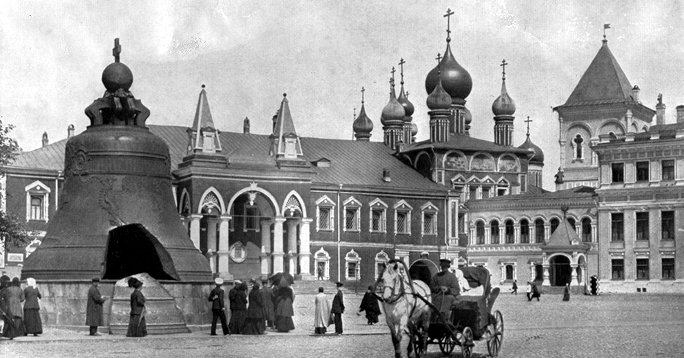| |
The monastery known as the "Miracle" Chudov was physically
erased by the Bolsheviks in the nineteen twenties after having served such
historical figures as the monk Dmitrii Otrep'ev as a place for scholarly
endeavors and others for nearly six centuries. Having thus prevented
archaeologists from doing their research, information on this important
institution is found in documentation. The "Miracle" is that of the
Archangel Michael who by the grace of God stemmed the tide of Lucifer's armies
at ......... The founder, Metropolitan Alexei (the Andronikov monastery was
also founded by him in 1359 or a year later), was a major figure in the
turbulent fourteenth century Rus' and as such was beified in 1483. Ivan III
built a special church with two altars: one in the name of the Annunciation
(for women) and the other after the saint Alexei (for men). The story of his
healing the Tatar khan's daughter. The heir apparent Vasilii Dmitrievich had to
flee Tochtamysh in 1386. He fled the Horde into Moldavia and then to the land
of the Livonian Order and then to Lithuania. Later after thirty year of
marriage, the widow Sophia Vitovtna in 1425 left the country in the hands of
Yurii Dmitrievich of Zvenigorod.
The principal source of information on the Chudov monastery is contained in the
agiographic literature contemporary and in later re-writings. Amongst the
authors are the monk Epithani who wrote the biography of Saint Sergei
Radonezhski, the monk Kiprian who was also a contemporary and wrote several
works devoted to church history such as the biography of Metropolitan Peter,
and following the disastrous battle of Kosovo Pole, the emigrant Serb monk
Pokhomii Logofet who arrived with the Greek metropolitan Fotii in the beginning
of the fifteenth century wrote the most important historical work on Rus' known
as the Cheti Minei and in our era the noted historian Pokrovskii. Regardless of
one's historical interpretation of the reasons for its founding, Mr. Beliaev
considers that it was founded no earlier than the third quarter of the
fourteeth century, likely at the time when the church of the Archangel Michael.
This question in his opinion will remain unanswered until additional
archaeological work is carried out.
In 1431, the stone church's walls collapsed, and a new smaller stone church was
built. In the opinion of N.N. Voronin, the original church had been built
without attention to such architectural details as a ground floor or a high and
wide wall underpining., as it is stated in Pakhomii Logofet's work devoted to
Sergei Radonezhski "the sole support was the ground it stood on." The
edifice was begun anew in the beginning of the sixteenth century, leaving the
present generation a complex structure with three tiers which was destroyed in
1929. Construction features of the original 1365 church may have been used in
the 1501-1504 building. Some architectural details of the later church have
been preserved for further study.
The cemetery of the sixteenth century was disturbed several times and as such
presents difficulty in historical research. The site of the monastery was well
defined by its surrounding structures. In the reign of Tsar Fyodor Alekseevich
the Annunciation church began seriously deteriorating and he ordered that it
and all buildings in the Chudov monastery be rebuilt with the blue prints
submitted to him for his approval. The church was on a high substructure whose
entryway was accessed by a high stairway and an additional chapel on the south
side was dead center of a rectangular square. Other churches in the complex
were named after Yevkokiya the Martyress consecrated in 1556 in the presence of
the tsar and the tsaritsa Anastasia I and the apostle Saint Andrei the First
Called, turned over to the sister of the Cross Hospital. A third was for the
martyrs Platon and roman later renamed to the Glory of All Saints.
The documentation is of some value as the archaeology cannot add to those
sources any pertinent data. Its analysis is outside the competence of the
archaeologists.
The site of the Chudov monastery is a square in front of the building of the
Presidium of the Supreme Council chambers and its western side. Beliaev feels
confident that archaeological work will be carried out to clarify any
tendencies to ascribe a more ancient dating to this monastery. Fortunately for
the visitor to the Kremlin there is a standing church of that period. The
church of Our Lady's Nativity and its older antecedent, the Church of
Resurection of St. Lazarus where both built by Yevdokiya, wife of prince
Dmitrii Ivanovich.
|
|


